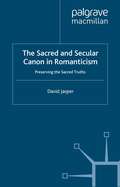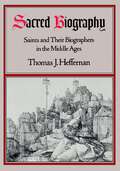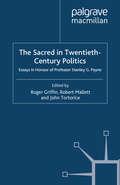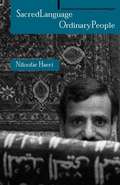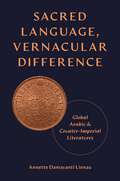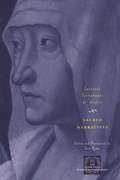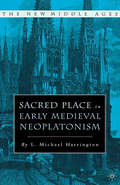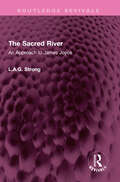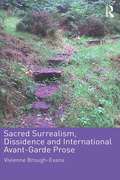- Table View
- List View
Sacramental Poetics at the Dawn of Secularism: When God Left the World (Cultural Memory in the Present #440)
by Regina Mara SchwartzSacramental Poetics at the Dawn of Secularism asks what happened when the world was shaken by challenges to the sacred order as people had known it, an order that regulated both their actions and beliefs. When Reformers gave up the doctrine of transubstantiation (even as they held onto revised forms of the Eucharist), they lost a doctrine that infuses all materiality, spirituality, and signification with the presence of God. That presence guaranteed the cleansing of human fault, the establishment of justice, the success of communication, the possibility of union with God and another, and love. These longings were not lost but displaced, Schwartz argues, onto other cultural forms in a movement from ritual to the arts, from the sacrament to the sacramental. Investigating the relationship of the arts to the sacred, Schwartz returns to the primary meaning of "sacramental" as "sign making," noting that because the sign always points beyond itself, it participates in transcendence, and this evocation of transcendence, of mystery, is the work of a sacramental poetics.
The Sacred and Secular Canon in Romanticism: Preserving the Sacred Truths (Romanticism in Perspective:Texts, Cultures, Histories)
by D. JasperThis book is an interdisciplinary study of Romanticism which focuses on the reception of the Biblical canon in poetry, art and theory. The Bible is acknowledged as the heart of European culture, but as its status as the sacred text of Judaism and Christianity becomes questionable, it remains at the turning-point between sacred and secular art in the modern world. The insights of Romanticism are crucial for our understanding of postmodernism as a fundamentally religious movement which acknowledges both the death and rebirth of religious language.
Sacred and Secular in Medieval and Early Modern Cultures: New Essays (The New Middle Ages)
by L. BessermanThis book illuminates the pervasive interplay of 'sacred' and 'secular' phenomena in the literature, history, politics, and religion of the Middle Ages and Early Modern periods. The essays gathered here constitute a new way of applying a classic dichotomy to major cultural phenomena of the pre-modern era.
Sacred Biography: Saints and Their Biographers in the Middle Ages
by Thomas J. HeffernanThough medieval "saints' lives" are among the oldest literary texts of Western vernacular culture, they are routinely patronized as "pious fiction" by modern historiography. This book demonstrates that to characterize the genre as fiction is to misunderstand the intentions of medieval authors, who were neither credulous fools nor men blinded by piety. Concentrating on English texts, Heffernan reconstructs the medieval perspective and considers sacred biography in relation to the community for which it was written; identifies the genre's rhetorical practices and purposes; and demonstrates the syncretistic way in which the life of the medieval saint was transformed from oral tales to sacred text. In the process, Heffernan not only achieves a more contextually accurate understanding of the medieval saints' lives, but details a new critical method that has important implications for the practice of textual criticism.
Sacred Cows: The Rushdie Affair - How it Seemed Then
by Fay WeldonIn 1989, after the Ayatollah Khomeini declared a fatwa against Salman Rushdie for writing The Satanic Verses, Fay Weldon published Sacred Cows, a pamphlet critical of the fundamentalist interpretation of the Koran. Weldon’s pamphlet received a lot of attention on publication – mostly criticism of her perceived ‘Islamophobia’ – but Weldon set out to enforce the notion that no religion should have the right to issue threats and intimidation; no religion should hinder free expression. In Sacred Cows, Weldon criticizes all aspects of British society – Murdoch and the Sun’s page 3 girls; white, liberal complacence; problems with education and the NHS – and argues that the affront to Muslim people in Britain was not caused by publication of The Satanic Verses itself but rather by the ‘awfulness of the society we have allowed to grow up around us’. The Satanic Verses is remedy, according to Weldon, to a fractured, ailing society. Publishing literature like this proves that our society ‘may yet be well and our brave new God of individual conscience may yet arise’.Originally published by Chatto & Windus as part of the 'Chatto Counterblasts' strand, this ebook edition is reissued with a new introduction by the author, as part of the Brain Shots series: the pre-eminent source for high quality, short-form digital non-fiction.
Sacred Engagements: Interfaith Marriage, Religious Toleration, and the British Novel, 1750–1820
by Alison ConwayA revelatory reading of the British novel that considers interfaith marriage, religious toleration, and the ethics of sociability.Bringing together feminist theory, novel criticism, and religious studies, Alison Conway's Sacred Engagements advances a postsecular reading of the novel that links religious tolerance and the eighteenth-century marriage plot. Conway explores the historical roots of the vexed questions that interfaith marriage continues to raise today. She argues that narrative wields the power to imagine conjugal and religious relations that support the embodied politics crucial to a communal, rather than state-sponsored, ethics of toleration.Conway studies the communal and gendered aspects of religious experience embedded in Samuel Richardson's account of interfaith marriage and liberalism's understandings of toleration in Sir Charles Grandison. In her readings of Frances Brooke, Elizabeth Inchbald, and Maria Edgeworth, Conway considers how women authors reframe the questions posed by Grandison, representing intimacy, authorship, and women's religious subjectivity in ways that challenge the social and political norms of Protestant British culture. She concludes with reflections on Jane Austen's Mansfield Park and the costs of a marriage plot that insists on religious conformity. By examining the complex epistemologies of the interfaith marriage plot, Sacred Engagements counters the secularization thesis that has long dominated eighteenth-century novel studies. In so doing, the book recognizes those subjects otherwise ignored by liberal political theory and extrapolates how a genuinely inclusive tolerance might be imagined in our own deeply divided times.
Sacred Engagements: Interfaith Marriage, Religious Toleration, and the British Novel, 1750–1820
by Alison ConwayA revelatory reading of the British novel that considers interfaith marriage, religious toleration, and the ethics of sociability.Bringing together feminist theory, novel criticism, and religious studies, Alison Conway's Sacred Engagements advances a postsecular reading of the novel that links religious tolerance and the eighteenth-century marriage plot. Conway explores the historical roots of the vexed questions that interfaith marriage continues to raise today. She argues that narrative wields the power to imagine conjugal and religious relations that support the embodied politics crucial to a communal, rather than state-sponsored, ethics of toleration.Conway studies the communal and gendered aspects of religious experience embedded in Samuel Richardson's account of interfaith marriage and liberalism's understandings of toleration in Sir Charles Grandison. In her readings of Frances Brooke, Elizabeth Inchbald, and Maria Edgeworth, Conway considers how women authors reframe the questions posed by Grandison, representing intimacy, authorship, and women's religious subjectivity in ways that challenge the social and political norms of Protestant British culture. She concludes with reflections on Jane Austen's Mansfield Park and the costs of a marriage plot that insists on religious conformity. By examining the complex epistemologies of the interfaith marriage plot, Sacred Engagements counters the secularization thesis that has long dominated eighteenth-century novel studies. In so doing, the book recognizes those subjects otherwise ignored by liberal political theory and extrapolates how a genuinely inclusive tolerance might be imagined in our own deeply divided times.
Sacred Iconographies in Chicana Cultural Productions (Comparative Feminist Studies)
by C. Román-OdioThis book examines the iconography of the Virgin of Guadalupe as a force for social justice and feminist emancipation within Chicana cultural productions from 1975-2010. In these productions the Virgin serves as a paradigm to unlock the histories of conquest and colonization, racism, and sexual oppression in the US-Mexico borderland and beyond.
The Sacred in Twentieth-Century Politics: Essays in Honour of Professor Stanley G. Payne
by R Griffin R. Mallett J. TortoriceThe emerging shape of the post Cold War world provides evidence that rather than diminishing, the profound intersection of political ideology and religious forms of belief is an ever more potent force in world affairs. This volume offers both theoretic underpinnings, and a comparative analysis that elucidates this potent and dangerous phenomenon.
Sacred Language, Ordinary People: Dilemmas of Culture and Politics in Egypt
by N. HaeriThe cultures and politics of nations around the world may be understood (or misunderstood) in any number of ways. For the Arab world, language is the crucial link for a better understanding of both. Classical Arabic is the official language of all Arab states although it is not spoken as a mother tongue by any group of Arabs. As the language of the Qur'an, it is also considered to be sacred. For more than a century and a half, writers and institutions have been engaged in struggles to modernize Classical Arabic in order to render it into a language of contemporary life. What have been the achievements and failures of such attempts? Can Classical Arabic be sacred and contemporary at one and the same time? This book attempts to answer such questions through an interpretation of the role that language plays in shaping the relations between culture, politics, and religion in Egypt.
Sacred Language, Vernacular Difference: Global Arabic and Counter-Imperial Literatures (Translation/Transnation #52)
by Annette Damayanti LienauHow Arabic influenced the evolution of vernacular literatures and anticolonial thought in Egypt, Indonesia, and SenegalSacred Language, Vernacular Difference offers a new understanding of Arabic&’s global position as the basis for comparing cultural and literary histories in countries separated by vast distances. By tracing controversies over the use of Arabic in three countries with distinct colonial legacies, Egypt, Indonesia, and Senegal, the book presents a new approach to the study of postcolonial literatures, anticolonial nationalisms, and the global circulation of pluralist ideas.Annette Damayanti Lienau presents the largely untold story of how Arabic, often understood in Africa and Asia as a language of Islamic ritual and precolonial commerce, assumed a transregional role as an anticolonial literary medium in the nineteenth and twentieth centuries. By examining how major writers and intellectuals across several generations grappled with the cultural asymmetries imposed by imperial Europe, Lienau shows that Arabic—as a cosmopolitan, interethnic, and interreligious language—complicated debates over questions of indigeneity, religious pluralism, counter-imperial nationalisms, and emerging nation-states.Unearthing parallels from West Africa to Southeast Asia, Sacred Language, Vernacular Difference argues that debates comparing the status of Arabic to other languages challenged not only Eurocentric but Arabocentric forms of ethnolinguistic and racial prejudice in both local and global terms.
The Sacred Life of Modernist Literature: Immanence, Occultism, and the Making of the Modern World
by Allan Kilner-JohnsonProbing the relationship between modernist literary experimentation and several key strands of occult practice which emerged in Europe from roughly 1894 to 1944, this book sets the work of leading modernist writers alongside lesser known female writers and writers in languages other than English to more fully portray the aesthetic and philosophical connections between modernism and the occult. Although the early decades of the twentieth century-the era of cocktails, motorcars, bobbed hair, and war-are often described as a period of newness and innovation, many writers of the time found inspiration and visionary brilliance by turning to the mysterious occult past. This book's principle intervention is to reimagine the contours and boundaries of literary modernism by welcoming into the conversation a number of significant female writers and writers in languages other than English who are often still relegated to the fringes of modernist studies. Well-remembered poets and novelists such as Ezra Pound, W.B. Yeats, and Aleister Crowley were tied to occult beliefs, and this book sets these leading figures alongside less well-remembered but equally splendid modernists including Paul Brunton, Mary Butts, Alexandra David-Neel, Florence Farr, Dion Fortune, Hermann Hesse, and Rudolf Steiner. From the little magazines where occultism and Fabianism were comfortable companions, to consulting rooms of psychoanalysts where archetypes were revealed to be both mystical and mundane, to the forbidden mountain trails that led to formidable spiritual teachers, the conditions of modernism were invariably those conditions which inspired a return to the occult traditions that many thinkers believed had long evaporated. Indeed, in many ways these traditions were the making of the modern world. By uncovering hidden hopes and anxieties that faced a newly modern Western Europe, this book demonstrates how literary modernists understood occultism as a universal form of cultural expression which has inspired creative exuberance since the dawn of civilisation.
The Sacred Life of Modernist Literature: Immanence, Occultism, and the Making of the Modern World
by Allan Kilner-JohnsonProbing the relationship between modernist literary experimentation and several key strands of occult practice which emerged in Europe from roughly 1894 to 1944, this book sets the work of leading modernist writers alongside lesser known female writers and writers in languages other than English to more fully portray the aesthetic and philosophical connections between modernism and the occult. Although the early decades of the twentieth century-the era of cocktails, motorcars, bobbed hair, and war-are often described as a period of newness and innovation, many writers of the time found inspiration and visionary brilliance by turning to the mysterious occult past. This book's principle intervention is to reimagine the contours and boundaries of literary modernism by welcoming into the conversation a number of significant female writers and writers in languages other than English who are often still relegated to the fringes of modernist studies. Well-remembered poets and novelists such as Ezra Pound, W.B. Yeats, and Aleister Crowley were tied to occult beliefs, and this book sets these leading figures alongside less well-remembered but equally splendid modernists including Paul Brunton, Mary Butts, Alexandra David-Neel, Florence Farr, Dion Fortune, Hermann Hesse, and Rudolf Steiner. From the little magazines where occultism and Fabianism were comfortable companions, to consulting rooms of psychoanalysts where archetypes were revealed to be both mystical and mundane, to the forbidden mountain trails that led to formidable spiritual teachers, the conditions of modernism were invariably those conditions which inspired a return to the occult traditions that many thinkers believed had long evaporated. Indeed, in many ways these traditions were the making of the modern world. By uncovering hidden hopes and anxieties that faced a newly modern Western Europe, this book demonstrates how literary modernists understood occultism as a universal form of cultural expression which has inspired creative exuberance since the dawn of civilisation.
Sacred Narratives (The Other Voice in Early Modern Europe)
by Lucrezia Tornabuoni de' MediciThe most prominent woman in Renaissance Florence, Lucrezia Tornabuoni de' Medici (1425-1482) lived during her city's golden age. Wife of Piero de' Medici and mother of Lorenzo the Magnificent, Tornabuoni exerted considerable influence on Florence's political and social affairs. She was also, as this volume illustrates, a gifted and prolific poet. This is the first major collection in any language of her extensive body of religious poems. Ranging from gentle lyrics on the Nativity to moving dialogues between a crucified Christ and the weeping sinner who kneels before him, the nine laudi (poems of praise) included here are among the few such poems known to have been written by a woman. Tornabuoni's five storie sacre, narrative poems based on the lives of biblical figures-three of whom, Judith, Susanna, and Esther, are Old Testament heroines-are virtually unique in their range and expressiveness. Together with Jane Tylus's substantial introduction, these poems offer us both a fascinating portrait of a highly educated and creative woman and a lively sense of cultural and social life in Renaissance Florence.
Sacred Narratives (The Other Voice in Early Modern Europe)
by Lucrezia Tornabuoni de' MediciThe most prominent woman in Renaissance Florence, Lucrezia Tornabuoni de' Medici (1425-1482) lived during her city's golden age. Wife of Piero de' Medici and mother of Lorenzo the Magnificent, Tornabuoni exerted considerable influence on Florence's political and social affairs. She was also, as this volume illustrates, a gifted and prolific poet. This is the first major collection in any language of her extensive body of religious poems. Ranging from gentle lyrics on the Nativity to moving dialogues between a crucified Christ and the weeping sinner who kneels before him, the nine laudi (poems of praise) included here are among the few such poems known to have been written by a woman. Tornabuoni's five storie sacre, narrative poems based on the lives of biblical figures-three of whom, Judith, Susanna, and Esther, are Old Testament heroines-are virtually unique in their range and expressiveness. Together with Jane Tylus's substantial introduction, these poems offer us both a fascinating portrait of a highly educated and creative woman and a lively sense of cultural and social life in Renaissance Florence.
Sacred Narratives (The Other Voice in Early Modern Europe)
by Lucrezia Tornabuoni de' MediciThe most prominent woman in Renaissance Florence, Lucrezia Tornabuoni de' Medici (1425-1482) lived during her city's golden age. Wife of Piero de' Medici and mother of Lorenzo the Magnificent, Tornabuoni exerted considerable influence on Florence's political and social affairs. She was also, as this volume illustrates, a gifted and prolific poet. This is the first major collection in any language of her extensive body of religious poems. Ranging from gentle lyrics on the Nativity to moving dialogues between a crucified Christ and the weeping sinner who kneels before him, the nine laudi (poems of praise) included here are among the few such poems known to have been written by a woman. Tornabuoni's five storie sacre, narrative poems based on the lives of biblical figures-three of whom, Judith, Susanna, and Esther, are Old Testament heroines-are virtually unique in their range and expressiveness. Together with Jane Tylus's substantial introduction, these poems offer us both a fascinating portrait of a highly educated and creative woman and a lively sense of cultural and social life in Renaissance Florence.
Sacred Place in Early Medieval Neoplatonism (The New Middle Ages)
by L. HarringtonThe twentieth-century discovered the concept of sacred place largely through the work of Martin Heidegger and Mircea Eliade. Their writings on sacred place respond to the modern manipulation of nature and secularization of space, and so may seem distinctively post-modern, but their work has an important and unacknowledged precedent in the Neoplatonism of Late Antiquity and the early Middle Ages. Sacred Place in Early Medieval Neoplatonism traces the appearance and development of sacred place in the writings of Neoplatonists from the third to ninth centuries, and sets them in the context of present-day debates over place and the sacred.
Sacred Realism: Religion and the Imagination in Modern Spanish Narrative
by Noel ValisIn this thoughtful and compelling book, leading Spanish literature scholar Noël Valis re-examines the role of Catholicism in the modern Spanish novel. While other studies of fiction and faith have focused largely on religious themes, Sacred Realism views the religious impulse as a crisis of modernity: a fundamental catalyst in the creative and moral development of Spanish narrative.
Sacred Rhetoric: The Christian Grand Style in the English Renaissance
by Debora K. Shuger"There are no studies of a sacred grand style in the English Renaissance," writes Debora Shuger, "because even according to its practitioners it was not supposed to exist." Yet the grand style forms the unacknowledged center of traditional rhetorical theory. In this first history of the grand style, Professor Shuger explores the growth of a Christian aesthetic out of the Classical grand style, showing its development from Isocrates to the sacred rhetorics of the Renaissance. These rhetorics advocate a Christian grand style neither pedantically mimetic nor playfully sophistic, whose models include Tacitus and the Bible, as well as Cicero, and whose theoretical sources embrace not only Cicero and Quintilian, but Hermogenes and Longinus. This style dominates the best and most scholarly rhetorics of the period--texts written in Latin and, while ignored by most recent scholars, extensively used in England throughout the sixteenth and seventeenth centuries. These works are the first attempts since Augustine's pioneering revision of Ciceronian rhetoric to reground ancient rhetorical theory on Christian epistemology and theology.According to Professor Shuger, the Christian grand style is passionate, vivid, dramatic, metaphoric--yet this emotional energy and sensuousness is shaped and legitimated by Renaissance religious culture. Thus sacred rhetoric cannot be considered apart from contemporary theories of cognition, emotion, selfhood, and signification. It mediates between word and world. Moreover, these texts suggest the almost forgotten centrality of neo-Latin scholarship during these years and provide a crucial theoretical context for England's great flowering of devotional prose and poetry.Originally published in 1988.The Princeton Legacy Library uses the latest print-on-demand technology to again make available previously out-of-print books from the distinguished backlist of Princeton University Press. These editions preserve the original texts of these important books while presenting them in durable paperback and hardcover editions. The goal of the Princeton Legacy Library is to vastly increase access to the rich scholarly heritage found in the thousands of books published by Princeton University Press since its founding in 1905.
Sacred Rhetorical Education in 19th Century America: Austin Phelps at Andover Theological Seminary (Routledge Studies in Rhetoric and Communication)
by Michael-John DePalmaThis book offers new insight into the ways rhetorical educators’ religious motives influenced the shape of nineteenth-century rhetorical education and invites scholars of writing and rhetoric to consider what the study of religiously-animated pedagogies might reveal about rhetorical education itself. The author studies the rhetorical pedagogy of Austin Phelps, the prominent preacher and professor of sacred rhetoric at Andover Theological Seminary, and his theologically-motivated adaptation of rhetorical education to fit the exigencies of preachers at the first graduate seminary in the United States. In disclosing how Phelps was guided by his Christian motives, the book offers a thorough examination of how professional rhetoric was taught, learned, and practiced in nineteenth-century America. It also provides an enriched understanding of rhetorical theories and pedagogies in American seminaries, and contributes deepened awareness of the ways religious motives can function as resources that enable the reshaping of rhetorical theory and pedagogy in generative ways. Exploring the implications of Phelps’s rhetorical theory and pedagogy for future studies of religious rhetoric, histories of rhetorical education, and twenty-first century writing pedagogy,this book will be essential reading for scholars and students of rhetoric, education, American history, religious education, and writing studies.
Sacred Rhetorical Education in 19th Century America: Austin Phelps at Andover Theological Seminary (Routledge Studies in Rhetoric and Communication)
by Michael-John DePalmaThis book offers new insight into the ways rhetorical educators’ religious motives influenced the shape of nineteenth-century rhetorical education and invites scholars of writing and rhetoric to consider what the study of religiously-animated pedagogies might reveal about rhetorical education itself. The author studies the rhetorical pedagogy of Austin Phelps, the prominent preacher and professor of sacred rhetoric at Andover Theological Seminary, and his theologically-motivated adaptation of rhetorical education to fit the exigencies of preachers at the first graduate seminary in the United States. In disclosing how Phelps was guided by his Christian motives, the book offers a thorough examination of how professional rhetoric was taught, learned, and practiced in nineteenth-century America. It also provides an enriched understanding of rhetorical theories and pedagogies in American seminaries, and contributes deepened awareness of the ways religious motives can function as resources that enable the reshaping of rhetorical theory and pedagogy in generative ways. Exploring the implications of Phelps’s rhetorical theory and pedagogy for future studies of religious rhetoric, histories of rhetorical education, and twenty-first century writing pedagogy,this book will be essential reading for scholars and students of rhetoric, education, American history, religious education, and writing studies.
The Sacred River: An Approach to James Joyce (Routledge Revivals)
by L.A.G. StrongFirst Published in 1949, The Sacred River attempts to present a survey of James Joyce’s work. In 1932 Mr Strong published an essay in the course of which he suggested that Work in Progress was the first full scale application to the novel of twentieth century ideas on space and time, demanding from the reader a radical change in practice. The essay was read by Joyce, and the theory subsequently confirmed. From that point Mr Strong has continued his study of Joyce. This work is limited to four main lines of approach: interest in singing and singers, a passion with Joyce; literature, in particular Shakespeare, Swift, Blake, and the Romantic Movement, of which the author believes Finnegans Wake to be the logical fulfilment; contemporary theories of psychology; and Christian metaphysics. Mr Strong’s first-hand acquaintance with Dublin in the early nineteen-hundreds has been a further help, as was his friendship with Yeats, A.E., and other Irish writers who knew Joyce personally. The result is a stimulating and provocative piece of criticism, of which we may safely say that it outruns its modest programme. This book is a must read for scholars and researchers of English literature.
The Sacred River: An Approach to James Joyce (Routledge Revivals)
by L.A.G. StrongFirst Published in 1949, The Sacred River attempts to present a survey of James Joyce’s work. In 1932 Mr Strong published an essay in the course of which he suggested that Work in Progress was the first full scale application to the novel of twentieth century ideas on space and time, demanding from the reader a radical change in practice. The essay was read by Joyce, and the theory subsequently confirmed. From that point Mr Strong has continued his study of Joyce. This work is limited to four main lines of approach: interest in singing and singers, a passion with Joyce; literature, in particular Shakespeare, Swift, Blake, and the Romantic Movement, of which the author believes Finnegans Wake to be the logical fulfilment; contemporary theories of psychology; and Christian metaphysics. Mr Strong’s first-hand acquaintance with Dublin in the early nineteen-hundreds has been a further help, as was his friendship with Yeats, A.E., and other Irish writers who knew Joyce personally. The result is a stimulating and provocative piece of criticism, of which we may safely say that it outruns its modest programme. This book is a must read for scholars and researchers of English literature.
Sacred Surrealism, Dissidence and International Avant-Garde Prose (Studies in Surrealism)
by Vivienne Brough-EvansVivienne Brough-Evans proposes a compelling new way of reevaluating aspects of international surrealism by means of the category of divin fou, and consequently deploys theories of sacred ecstasy as developed by the Collège de Sociologie (1937–39) as a critical tool in shedding new light on the literary oeuvre of non-French writers who worked both within and against a surrealist framework. The minor surrealist genre of prose literature is considered herein, rather than surrealism's mainstay, poetry, with the intention of fracturing preconceptions regarding the medium of surrealist expression. The aim is to explore whether International surrealism can begin to be more fully explained by an occluded strain of 'dissident' surrealist thought that searches outside the self through the affects of ekstasis. Bretonian surrealism is widely discussed in the field of surrealist studies, and there is a need to consider what is left out of surrealist practice when analysed through this Bretonian lens. The Collège de Sociologie and Georges Bataille's theories provide a model of such elements of 'dissident' surrealism, which is used to analyse surrealist or surrealist influenced prose by Alejo Carpentier, Leonora Carrington and Gellu Naum respectively representing postcolonial, feminist and Balkan locutions. The Collège and Bataille's 'dissident' surrealism diverges significantly from the concerns and approach towards the subject explored by surrealism. Using the concept of ekstasis to organise Bataille's theoretical ideas of excess and 'inner experience' and the Collège's thoughts on the sacred it is possible to propose a new way of reading types of International surrealist literature, many of which do not come to the forefront of the surrealist literary oeuvre.
Sacred Surrealism, Dissidence and International Avant-Garde Prose (Studies in Surrealism)
by Vivienne Brough-EvansVivienne Brough-Evans proposes a compelling new way of reevaluating aspects of international surrealism by means of the category of divin fou, and consequently deploys theories of sacred ecstasy as developed by the Collège de Sociologie (1937–39) as a critical tool in shedding new light on the literary oeuvre of non-French writers who worked both within and against a surrealist framework. The minor surrealist genre of prose literature is considered herein, rather than surrealism's mainstay, poetry, with the intention of fracturing preconceptions regarding the medium of surrealist expression. The aim is to explore whether International surrealism can begin to be more fully explained by an occluded strain of 'dissident' surrealist thought that searches outside the self through the affects of ekstasis. Bretonian surrealism is widely discussed in the field of surrealist studies, and there is a need to consider what is left out of surrealist practice when analysed through this Bretonian lens. The Collège de Sociologie and Georges Bataille's theories provide a model of such elements of 'dissident' surrealism, which is used to analyse surrealist or surrealist influenced prose by Alejo Carpentier, Leonora Carrington and Gellu Naum respectively representing postcolonial, feminist and Balkan locutions. The Collège and Bataille's 'dissident' surrealism diverges significantly from the concerns and approach towards the subject explored by surrealism. Using the concept of ekstasis to organise Bataille's theoretical ideas of excess and 'inner experience' and the Collège's thoughts on the sacred it is possible to propose a new way of reading types of International surrealist literature, many of which do not come to the forefront of the surrealist literary oeuvre.

